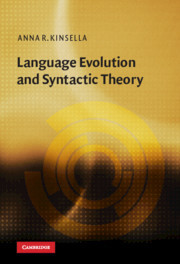Book contents
- Frontmatter
- Contents
- List of figures
- List of tables
- Preface
- List of abbreviations
- 1 Constraining our theory of language
- 2 Language as a perfect system
- 3 Language as an evolvable system
- 4 Language as a recursive system
- 5 Language as a minimal system
- 6 Towards an evolvable theory of syntax
- Bibliography
- Index
4 - Language as a recursive system
Published online by Cambridge University Press: 30 September 2009
- Frontmatter
- Contents
- List of figures
- List of tables
- Preface
- List of abbreviations
- 1 Constraining our theory of language
- 2 Language as a perfect system
- 3 Language as an evolvable system
- 4 Language as a recursive system
- 5 Language as a minimal system
- 6 Towards an evolvable theory of syntax
- Bibliography
- Index
Summary
Introduction
In this chapter, the argument will take a somewhat different tack. Up to now, it has been the general theoretical themes of the MP that have been under attack from an evolutionary standpoint. In chapter 5, the specifics of minimalist syntactic theories will be examined in a similar light. Before that, this chapter will put one evolutionary hypothesis, which is clearly consonant with minimalist thinking, under the spotlight.
Hauser et al. (2002) propose that the core component underlying language is recursion, and that all other intricacies and peculiarities of our linguistic capacity are the result of the recursive component having to interface with systems of the brain which are external to language, but are called upon in the course of processing language. As the one property which permits human language to be given the label of unique, what is interesting from an evolutionary view is the emergence of recursion.
It is important to take heed of the authors' disclaimer. They do not ‘define FLN as recursion by theoretical fiat’ (Fitch et al. 2005: 183). Indeed, in places, they appear to retreat to a weaker position. However, as they also note, ‘[t]he contents of FLN are to be empirically determined’ (p. 182). That is, the recursion-only hypothesis is just that, a hypothesis about the nature of language and its evolution, and the only way to prove or disprove it is to examine the empirical data. That is precisely what this chapter will do – use the empirical data to assess the hypothesis that ‘FLN only includes recursion’ (Hauser et al. 2002: 1569).
Section 4.2 will examine in detail what the term recursion refers to.
- Type
- Chapter
- Information
- Language Evolution and Syntactic Theory , pp. 112 - 159Publisher: Cambridge University PressPrint publication year: 2009



